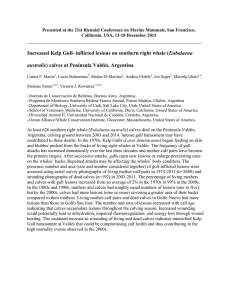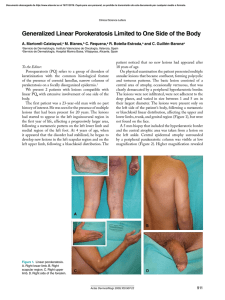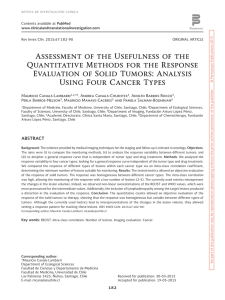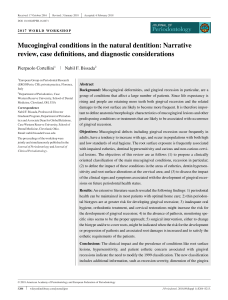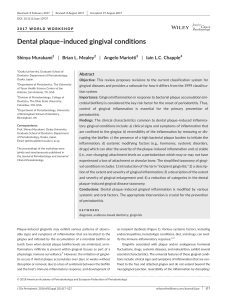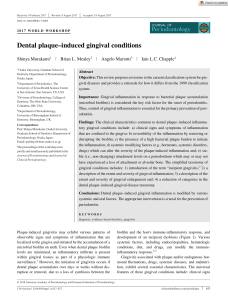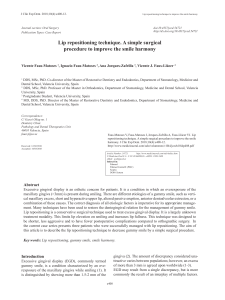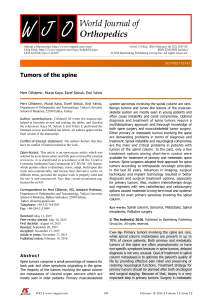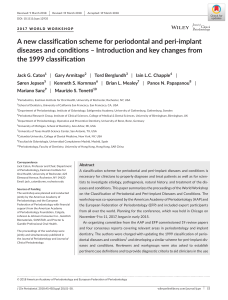lopez et al.def
Anuncio
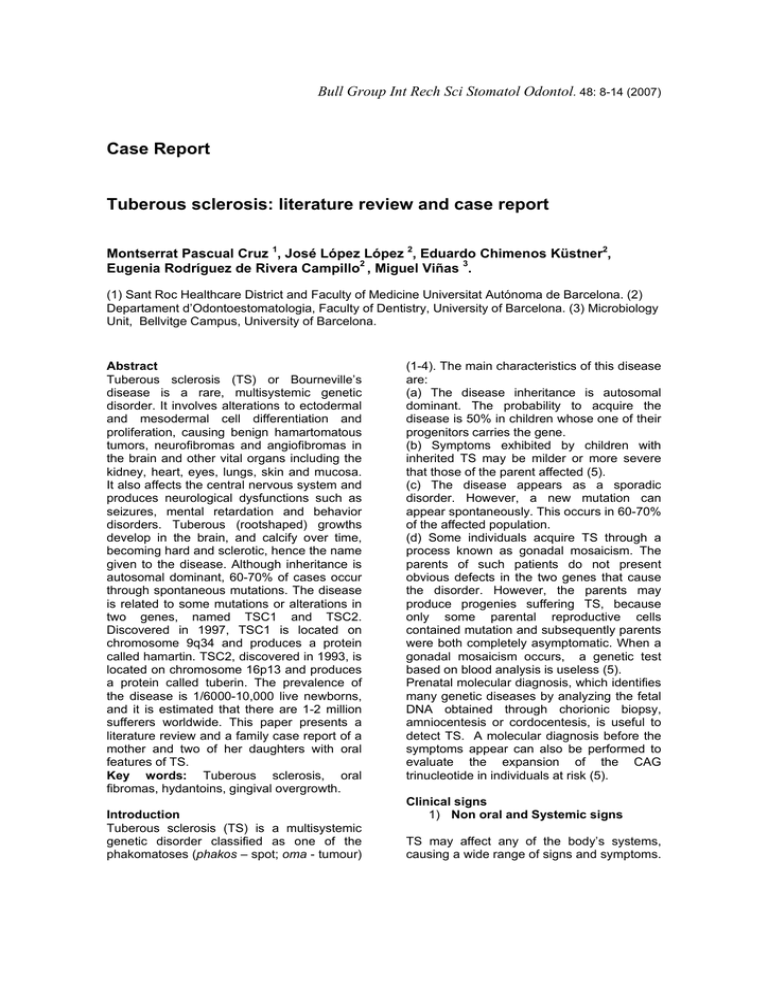
Bull Group Int Rech Sci Stomatol Odontol. 48: 8-14 (2007) Case Report Tuberous sclerosis: literature review and case report Montserrat Pascual Cruz 1, José López López 2, Eduardo Chimenos Küstner2, Eugenia Rodríguez de Rivera Campillo2 , Miguel Viñas 3. (1) Sant Roc Healthcare District and Faculty of Medicine Universitat Autónoma de Barcelona. (2) Departament d’Odontoestomatologia, Faculty of Dentistry, University of Barcelona. (3) Microbiology Unit, Bellvitge Campus, University of Barcelona. Abstract Tuberous sclerosis (TS) or Bourneville’s disease is a rare, multisystemic genetic disorder. It involves alterations to ectodermal and mesodermal cell differentiation and proliferation, causing benign hamartomatous tumors, neurofibromas and angiofibromas in the brain and other vital organs including the kidney, heart, eyes, lungs, skin and mucosa. It also affects the central nervous system and produces neurological dysfunctions such as seizures, mental retardation and behavior disorders. Tuberous (rootshaped) growths develop in the brain, and calcify over time, becoming hard and sclerotic, hence the name given to the disease. Although inheritance is autosomal dominant, 60-70% of cases occur through spontaneous mutations. The disease is related to some mutations or alterations in two genes, named TSC1 and TSC2. Discovered in 1997, TSC1 is located on chromosome 9q34 and produces a protein called hamartin. TSC2, discovered in 1993, is located on chromosome 16p13 and produces a protein called tuberin. The prevalence of the disease is 1/6000-10,000 live newborns, and it is estimated that there are 1-2 million sufferers worldwide. This paper presents a literature review and a family case report of a mother and two of her daughters with oral features of TS. Key words: Tuberous sclerosis, oral fibromas, hydantoins, gingival overgrowth. Introduction Tuberous sclerosis (TS) is a multisystemic genetic disorder classified as one of the phakomatoses (phakos – spot; oma - tumour) (1-4). The main characteristics of this disease are: (a) The disease inheritance is autosomal dominant. The probability to acquire the disease is 50% in children whose one of their progenitors carries the gene. (b) Symptoms exhibited by children with inherited TS may be milder or more severe that those of the parent affected (5). (c) The disease appears as a sporadic disorder. However, a new mutation can appear spontaneously. This occurs in 60-70% of the affected population. (d) Some individuals acquire TS through a process known as gonadal mosaicism. The parents of such patients do not present obvious defects in the two genes that cause the disorder. However, the parents may produce progenies suffering TS, because only some parental reproductive cells contained mutation and subsequently parents were both completely asymptomatic. When a gonadal mosaicism occurs, a genetic test based on blood analysis is useless (5). Prenatal molecular diagnosis, which identifies many genetic diseases by analyzing the fetal DNA obtained through chorionic biopsy, amniocentesis or cordocentesis, is useful to detect TS. A molecular diagnosis before the symptoms appear can also be performed to evaluate the expansion of the CAG trinucleotide in individuals at risk (5). Clinical signs 1) Non oral and Systemic signs TS may affect any of the body’s systems, causing a wide range of signs and symptoms. Bull Group Int Rech Sci Stomatol Odontol. 48: 8-14 (2007) The natural course of the disease varies from one individual to another; also symptoms may range from very mild to extremely severe. Common symptoms include seizures in 8090% of cases (6), mental retardation, behavior disorders (high frequency of autism) and skin abnormalities. Benign tumors are common and may appear in any organ, although they are more frequent in the brain, kidneys, heart and skin. In contrast, malign tumors are rare; when existing, there is a tendency to affect the kidneys with renal cell carcinoma. The following features should be considered as particularly important: - Brain tumors: these can be of three types: cortical tubers, which usually appear on the surface of the brain, subependymal nodules located on the walls of the ventricles, and giant cell astrocytomas, which may block liquid flow within the brain and increase pressure, thus leading to cephaleas. - Neurological disorders: Between half and two-thirds of patients exhibited some type of epileptic seizure (tonic, tonic-clonic, partial myoclonic or generalized), infantile spasms with hypsarrhythmia (West’s syndrome) and mental disabilities ranging from mild learning difficulties to severe mental retardation. - Behavior problems: these include attention deficit and hyperactivity, obsessivecompulsive disorder, sudden rage and even aggression. - Renal problems: angiomyolipomas, benign growths formed by fatty tissue and muscle cells. These tend to be bilateral and asymptomatic; however, they may reach a considerable size causing retroperitoneal bleeding, pain, weakness, severe anemia, reduced arterial pressure and renal failure. This is the primary cause of death among these patients (7). - Cardiac tumors: rhabdomyomas. When these tumors are large or multiple they may block the vessel circulation and cause death; this usually occurs immediately after delivery. - Eye lesions: benign tumors known as phakomas, appearing as whitish, mulberrylike spots on the retina; generally they do not cause loss of vision. They are pathognomonic of this disease. Eyelid angiofibromas have also been described (8). - Dermatological signs: 1) hypomelanotic macules (“ash-leaf” spots), lighter in color than the skin and which may appear on any part of the body; 2) red marks or spots known as facial angiofibromas or Pringle’s sebaceous adenomas that appear on the face and are formed by blood vessels and fibrous tissue. They normally spread out symmetrically in the shape of butterfly wings in the nasogenian folds around the nose, cheeks and chin, and often cause facial disfiguration; 3) plaques on the forehead, in the form of raised and discolored areas; 4) small fleshy tumors known as fingernail angiofibromas (Koenen tumors) that grow around or under feet and hands' nails; 5) some areas where the skin has an orangepeel texture (shagreen patch) are generally observed on the lower back. - Bone alterations: these are usually geodes 1-3 mm in size of a pseudocystic nature, on metacarpal, metatarsal or phalangeal location, or alternatively areas of hyperostosis (1). 2) Oral signs The incidence of oral lesions ranges from 1156% of patients (1,9). These usually take the form of fibromas located in the gums, mucosa, lips and base of the tongue. Enamel hypoplasia frequently appears in these patients, consisting of small pitted areas with an average size of 80 microns. They localize on the exposed face of the teeth and only affect the enamel, without damaging the dentine, and do not lead to caries (1,10). A single case of fibrous tumors in the maxillary bones has also been reported. Celenk and coworkers described a case in which there was a unique, hard and wellcircumscribed mass in the mandibular symphysis of a 15-year-old patient affected with TS classified as fibrolipomatous hamartoma (2). Diagnosis Diagnosis is based on careful clinical examination coupled with computerised tomography (TC) — very useful for detecting calcified tubers in the brain — and magnetic resonance (MR), which enables cortical tubers to be detected (1). Early diagnosis in very small children is carried out in the event of seizures convulsions (infantile spasms) at birth or the presence of cardiac rhabdomyomas. Prenatal diagnosis is also performed in patients at risk (5). Bull Group Int Rech Sci Stomatol Odontol. 48: 8-14 (2007) Case report The patients were a 69-year-old woman (C.A.G.), attending the dental clinic in a primary healthcare centre for a tooth extraction, and her 38 years old daughter (N.T.A.).. Their clinical histories revealed a diagnosis of TS and epilepsy, and both were previously treated with anti-convulsive drugs (phenytoin). No information on complementary tests was available whereas no toxic habits were reported. The medical history contained no other significant information. The history-taking and exploration revealed oligophrenia, attention deficit and hyperactivity in the mother, and moderate mental retardation in the daughter. The facial and body examination showed facial angiofibromas (Fig. 1) in both patients and fingernai angiofibromas (Koenen tumors) on feet and hands (Fig. 2), as well as a shagreen patch on the daughter. Figure 2. C.A.G. Toenail angiofibromas. showed some lesions on the edges of the tongue and in the palate (Fig. 5). Figure 3. C.A.G. Exophytic lesions with a granulomatous appearance. Figure 1. C.A.G. Facial angiofibromas. Examination of the mouth revealed poor oral hygiene, with chronic periodontitis, missing and displaced teeth, and a low caries index. Exploration of the mucosa showed, in the mother, multiple exophytic gum lesions, with a granulomatous appearance but without bleeding; they were the normal pink colour of the adjacent mucosa and were more frequent in the edentulous areas (Fig. 3). Similar lesions, although less widespread and raised, were observed on the cheek mucosa (Fig. 4). The daughter presented fewer lesions more spread on the oral mucosa. Both patients The histopathological analysis of the mother’s biopsy revealed fibroepithelial hyperplasia, with profuse vascularisation, compatible with angiofibroma (Fig. 6). We could further examine another daughter (C.T.A.), aged 43 and also suffering TS and mild mental retardation. She showed almost identical oral manifestations: chronic periodontitis, missing and displaced teeth, and a low caries index. The exploration of skin and oral mucosa revealed fewer facial angiofibromas (she had undergone CO2 laser treatment on the skin), Koenen tumors and hypopigmentation; there were also widely Bull Group Int Rech Sci Stomatol Odontol. 48: 8-14 (2007) osteolytic image that was difficult to distinguish from the venous lacunae. The panoramic X-rays revealed no significant bone alterations, except for horizontal bone loss secondary to the periodontal disease in the three patients. The family history showed an increased incidence of the disease among female members (Fig. 8). Figure 4. C.A.G. Exophytic lesions with a granulomatous appearance on the cheek mucosa. dispersed fibromas in the gum and cheek mucosa. Neurological examination of the three patients revealed normal cranial nerves, preserved strength, normal sensitivity, normal finger-nose and heel-knee coordination, except for the mother, who presented a staggering gait and a positive Romberg sign. Several imaging diagnostic tests were performed (cranial CT, head X-ray, oral panoramic scan, X-ray of wrists and hips) with the following results: - CT of the younger daughter: showed multiple cortical hamartomas, one of them calcified. Some alterations of the periventricular materia alba and subependymal nodules were detected; some of these were calcified, whereas the rest had clear appearance after endovenous contrast. - X-rays revealed various intra-medullar osteolytic areas in phalanges and irregularities in the metacarpal cortical area, increased bone density in the sacral region and areas of sclerosis with pedicles in the youngest patient, compatible with osteoblastic deposits. Head X-rays revealed calcifications in all three patients. In one patient, shown in Fig. 7, there was enlargement and increased density of both cranial tables, patches of sclerosis in the inner table, intracranial calcifications and an Figure 5. N.T.A. Exophytic lesions with a granulomatous appearance. Discussion Only a few clinical cases of TS with oral clinical signs have been reported (1,2,9,11). It has been suggested that oral fibromas may not be truly TS lesions, but rather caused by the drugs used to treat the neurological disorders related to this disease (9). Hydantoins produce secondary gingival hypertrophy, when significant amounts of bacterial plaque is present (12,13). In a study by Lygidakis and coworkers oral fibromas were observed in 46% of ET patients, many of whom had never been treated with phenytoin or other anti-epileptic drugs (11). In addition, several studies have related hydantoin-induced hyperplasia to a range of factors including age and tobacco and alcohol consumption (14). Similar results were obtained by Thomason and coworkers, who argued that the likelihood of developing gingival hypertrophy was higher among children and adolescents than in adults. Thus, there would be an inverse relationship between age and gingival overgrowth (15). Bull Group Int Rech Sci Stomatol Odontol. 48: 8-14 (2007) Regarding the presence of gingival fibromas, the oldest patient presented the largest and greatest number of nodules, as opposed to gingival overgrowth due to hydantoins as argued by Thomason y Gilman. This would Figure 7. N.T.A. Enlargement and increased density of both cranial tables Figure 6. N.T.A. Fibroepithelial hyperplasia showing vascular formations compatible with angiofibroma. Finally, Peñarrocha and coworkers argue that gingival overgrowth is a phenotypic presentation of the patient’s genetic response/susceptibility to the mitotic effect of phenytoin (16). Patients herein studied lack toxic habits; none of them exhibited significant gingival hyperplasia despite they were treated with anticonvulsants. In gingival hyperplasia induced by phenytoin administration gums appear pink and homogenous whereas gingival lesions in TS appear as nipple-like, fibrous nodules often bleeding (9). This clinical finding was confirmed by histological data. Our patients´gingival health can be defined as chronic periodontitis enhanced by poor hygiene, and include typical TS-associated lesions in terms of the distribution, clustering, color and texture of the lesions. seem to support the hypothesis of gingival overgrowth as the patient’s genetic response/susceptibility to the mitotic effect of phenytoin, independent of the oral signs typically associated with TS. The importance of correct oral hygiene should be stressed in order to avoid risk factors that enhance periodontal disease of these patients. In summary, the patients described in the present work did not attend their dental appointment to assess the oral lesions associated with their base pathology but others. However, in our opinion, the dentist should be aware of these kind of lesions, in order to better control them and to offer adequate advice for their treatment Bull Group Int Rech Sci Stomatol Odontol. 48: 8-14 (2007) Figure 8. Family tree. Patients studied: (TS): Tuberous sclerosis NC: No clinical features (genotype was not studied in these patients) REFERENCES 1. López-López J, Rodríguez de RiveraCampillo E, Marques-Soares S, FinestresZubeldia F, Chimenos-Küstner E, RosellóLlabrés X. Esclerosis Tuberosa y manifestaciones orales. Caso clínico. Med Oral 2004; 9:216-23. 2. Celenk P, Alkan A, Canger EM, Gunhan O. Fibrolipomatous hamartoma in a patient with tuberous sclerosis: Report of a case. Oral Surg Oral Med Oral Pathol Oral Radiol Endod 2005, 99:202-6. 3.http://www.ninds.nih.gov/disorders/tuberous _sclerosis/detail_tuberous_sclerosis.htm. Accessed in June 2005 (Office of Communications and Public Liaison. National Institute of Neurological Disorders and Stroke. National Institutes of Health: Bethesda. NIH 01-1846s; 2003) 4. Alfaro A. Anomalías del desarrollo del sistema nervioso central. In: Medicina Interna. Farreras Rozman. Barcelona: Harcourt; 2000. pp. 1707-17 5. Roach ES, Sparagana SP. Diagnosis of tuberous sclerosis complex. J Child Neurol 2004; 19: 643-9. 6. Curatolo P. Tuberous sclerosis complex: from basic science to clinical phenotypes. London: MacKeith Press; 2003. 7. Álvarez-Rodríguez E, Torres–Gárate R, Rojano-Martín B, Gutierrez-Larraínzar A, Maroto-Rubio M, Lozano-Tonkín C. Cartas al director: Angiomiolipomatosis renal y esclerosis tuberosa. Anales de Medicina Interna 2004; 21:69. 8. Mencía-Gutiérrez E. Lesiones palpebrales y cutáneas como única manifestación de la esclerosis tuberosa. Arch Soc Esp Oftalmol 2004; 79: 401-4. 9. López E, Escovich L, Vigna A. Esclerosis Tuberosa: Presentación de un caso clínico con manifestaciones estomatológicas. Med Oral 2003; 8:122-8. 10. Babu KL, Rai K, Hegde AM Tuberous sclerosis. A case report. J Cli Pediatr Dent 2004; 28: 347-9. 11. Lygidakis NA, Lindenbaum RH. Oral fibromatosis in tuberous sclerosis. Oral Surg Oral Med Oral Pathol 1989; 68:725-8. 12. Majola MP, McFadyen ML, Connolly C, Nair YP, Govender M. Factors influencing induced gingival enlargement. J. Clin Periodontol 2000; 27:506-12. 13. Kuru L, Yilmaz S, Kuru B, Köse KN, Noyan Ü. Expression of growth factors in the gingival crevice fluid of patients with phenytoin-induced gingival enlargement. Archives of Oral Biology 2004; 49: 945-50. 14. Majola MP, McFadyen ML, Connolly C, Nair YP, Govender M, Laher MH. Factors influencing phenytoin-induced gingival enlargement. J Clin Periodontol 2000; 27(7):506-12. Bull Group Int Rech Sci Stomatol Odontol. 48: 8-14 (2007) 15. Thomason JM, Seymour RA, Rawlins MD. Incidence and severity of phenytoininduced gingival overgrowth in epileptic patients in general medical practice. Community Dent Oral Epidemiol 1992; 20: 288-91. 16. Peñarrocha-Diago M, Bagan-Sebastian JV, Vera-Sempere F. Diphenylhydantoininduced gingival overgrowth in man: a clinicopathological study. J Periodontol 1990; 61:571-4. Address for correspondence José López López Campus de Bellvitge Pavelló de Govern, 2ª pl. Derpartament d’Odontoestomatologia C/Feixa Llarga, s/n 08907 L’Hospitalet de LLobregat (Barcelona, Spain) Email: [email protected]
